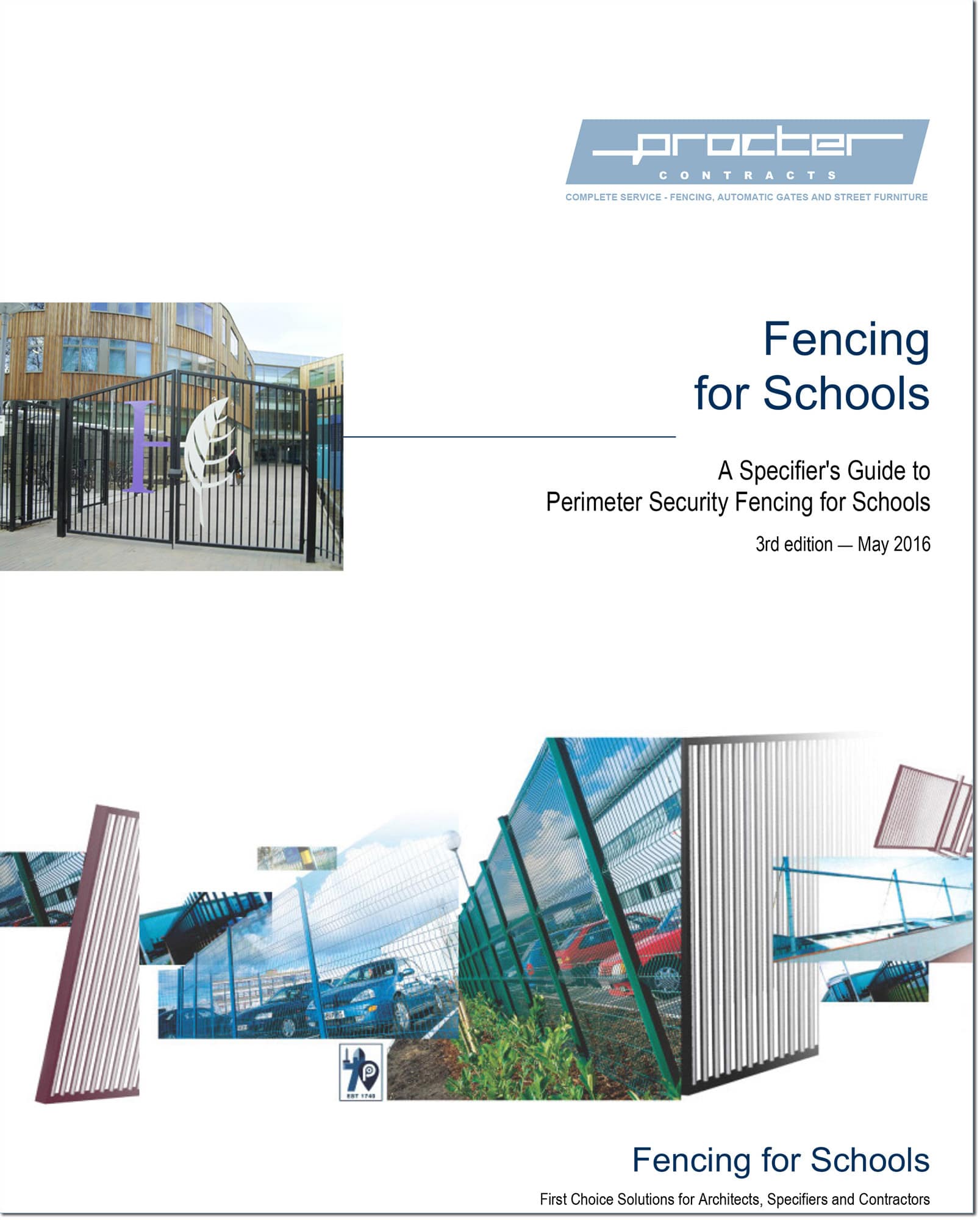Fencing for Schools
A Specifier’s Guide to Perimeter Security Fencing for Schools
School security is a multi-faceted subject. As well as parents expecting their children to be safe from intruders, schools want to prevent truancy by controlling when and where children can leave. In addition, the personal safety of pupils, staff and visitors is of considerable concern to Local Education Authorities (LEAs), academy trusts and governing bodies.
Currently, there is little official guidance available in relation to school perimeter security, though the Ofsted School inspection handbook, published in 2015, states:
Inspectors will always have regard for how well children and learners are helped and protected so that they are kept safe. Although inspectors will not provide a separate grade for this key aspect of a provider’s work, inspectors will always make a written judgement under leadership and management in the report about whether or not the arrangements for safeguarding children and learners are effective.
This is in contrast to Ofsted’s 2010 guidance for inspectors, Briefing for section 5 inspectors on safeguarding children, which stated:
Inspectors should take into account the extent to which the school takes reasonable steps to ensure that pupils are safe on the school site, for example by monitoring visitors or volunteers or those using the premises during school time.
Does the school have adequate security arrangements for the grounds and buildings?
Whether or not anything from Ofsted or DfE (the Department for Education) states explicitly that perimeter security is important, common sense tells us that fencing and gates are the first line of defence and have a vital role to play.
Today’s schools contain valuable and portable property that is attractive to thieves, and arson is a significant problem that can, to a large extent, be tackled by preventing unauthorised access. According to a report The impact of school fires published in 2007 by the National Foundation for Educational Research, there are estimated to be 1400 to 1800 fires in schools each year (27 to 35 per week), with a real cost each year likely to be well over £100 million. One in eight schools suffers a serious arson attack, and around two-thirds of school fires start outside normal school hours. Clearly, good perimeter security can help to reduce incidents of school arson.
Nevertheless, schools have to remain an attractive learning environment, and schools are encouraged to open their facilities to the wider community at other times. Adequate security, therefore, has to be achieved without schools looking like prisons. Furthermore, research shows that aggressive security measures can make establishments appear at risk; and if there is a perception that crimes are being committed, this can lead to an increase in crime.
School perimeter security is further complicated by the need to meet legal and planning requirements, and security has to be considered as a complete package including fencing and other appropriate measures such as CCTV, access control and security lighting. Every school has its own needs and challenges, so the solution to the problem is different in each case.
Fencing is the most important of the available security measures, as highlighted in a survey of LEAs undertaken by GHK (Research Report reference RR419). The results, School Security Concerns (ISBN 1 84185 972 9), published in 2003 by what was then DfES, put perimeter security at the top of the hierarchy of preventative measures, and at the top of the LEAs’ list of measures that work well. One LEA described a 75 per cent reduction in crime and trespass resulting from the installation of perimeter fencing.
Given the importance of fencing and the complexity of the context, this specifier’s guide to perimeter security fencing for schools explains the different options available, presents the advantages and limitations of each, and steers the reader towards making decisions that will provide the right level of security at an acceptable cost and without compromising other areas such as aesthetics.
School perimeter fencing achieves the following…
- Marks the school’s boundaries
- Deters casual trespassers and/or determined intruders
- Increases the time it takes or determined intruders breach the security
- Prevents pupils leaving the school without permission
- Prevents unauthorised removal of property
- Compliance with insurer’s requirements in terms of theft, damage and public liability
Security starts with a risk assessment
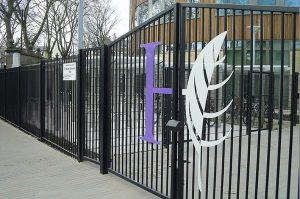
This has a three-part checklist that covers the factors to consider:
- Incidence of crime
- Environment and buildings
- Security measures
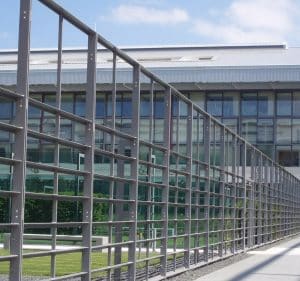
Risk assessments also need to be reviewed as follows:
- periodically – to check whether there have been any significant changes to the factors considered in the initial assessment
- in response to any changes in circumstances — such as an increase in the value of the property being protected, a spate of theft, vandalism or arson attacks, or an increase in security at other schools in the vicinity that could result in the phenomenon known as crime displacement
For schools that have been assessed as being medium or high risk, it is recommended that advice is sought from a professional risk manager, as a risk assessment conducted incorrectly will give misleading results that could cost the school dear — either as a result of insufficient security being put in place or excessive expenditure on an unnecessarily high level of security.
Perimeter fencing as part of a security package
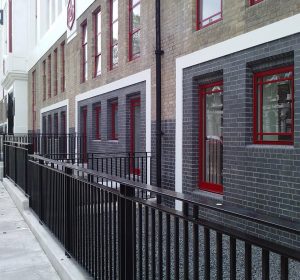
In some cases the best approach is to install perimeter fencing around the complete school boundary but, elsewhere, it might be more appropriate to use fencing as part of a package of measures to secure a smaller area around the school buildings. Other measures might include walling, security lighting, CCTV, intruder alarms, automatic fire detection/alarm/sprinkler systems, shutters and grilles on windows and doors, entrances with access controls, defensive hedging (eg hawthorn), barriers and bollards, and security guards on patrol.
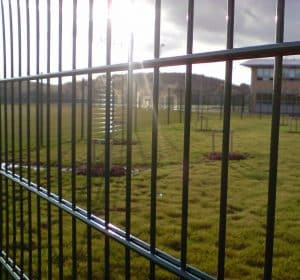
More information about reducing risks and implementing security measures is contained in a free 60-page guide, New Schools 2014, published by the Secured by Design police initiative, and in an Interactive Design Guide based on the same material, both of which are available from the Secured by Design website (see Useful Resources below). In addition, the Safer Schools and Hospitals Toolkit contains a wealth of useful guidance; this was published on the Home Office’s Crime Reduction website in 2005 but is currently only available via the National Archives (see Useful Resources below).
Choosing the right type of perimeter fencing
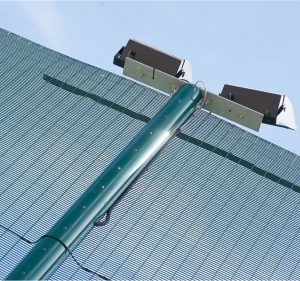
Most schools will want fencing to be coloured for aesthetic reasons, but it should be remembered that dark fencing provides easier through-visibility and, therefore, better security.
Where sloping ground needs to be fenced, the fencing should be stepped or raked to ensure that the appropriate minimum height is maintained and there are no gaps beneath the fence.
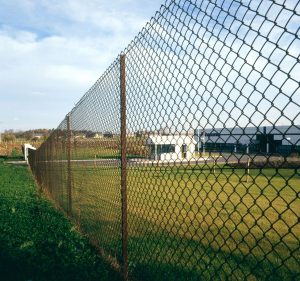
More detailed information about the selection of fencing and other security measures can be found in the SBD New Schools 2014 document.
Chain link fencing was popular for decades due to its low cost and versatility, being available in a range of strengths and finishes including galvanised and plastic-coated options. It is easily adapted to uneven ground and can be mounted on steel or concrete posts with or without additional security features (see below). Today, however, chain link fencing is considered suitable only for low-security applications such as boundary demarcation and the problem remains that chain link fencing is easily damaged and quickly becomes distorted, unsightly and ineffective at providing perimeter protection.
Timber fencing is suitable for only a limited range of applications around schools, as it provides very little protection against intruders, is combustible and easily vandalised, and most designs provide no through-visibility. Depending on any pretreatment, it can also need periodic maintenance.
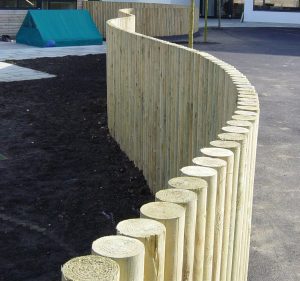
Vertical bar (railing) fencing is similar in concept to palisade fencing but is not as visually obtrusive, having a less industrial appearance. The level of security is similar to or better than that provided by palisade fencing, and there is normally a choice of top finials for the vertical rails. Purchase and installation costs, however, tend to be slightly higher than for comparable palisade fencing due to the greater manufacturing cost. As with the other types of fencing, matching gates can also be manufactured.
Welded wire mesh (weldmesh) panels provide a more secure type of fencing and this type of fencing is often the preferred option for schools. It takes many times longer to cut through than most alternatives and can be significantly harder to scale due to the lack of hand and footholds — provided the mesh is sufficiently small, of course. Welded mesh fencing is normally galvanised to provide a long-lasting finish, and polyester powder coating can be used on top of the galvanising to add colour. Although the top of the weldmesh panel can provide only limited anti-climb features (a short vertical wire), toppings can be mounted on the supporting posts to increase security.
Additional security features
Fence extensions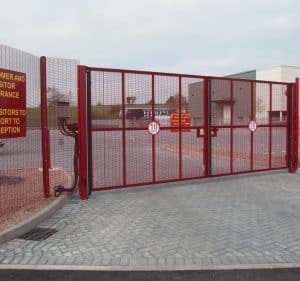
However, great care must be taken when specifying toppings that could potentially cause injury. There is, for example, a legal requirement to mount the toppings visibly so that anyone can see them as they approach the fence, and, with certain toppings, there should be warning signs mounted on the fence at regular intervals, and these signs should be visible/lit at night. It is never recommended to use an anti-climb topping below 1.8m and, additionally, local planning restrictions may not permit the use of certain types of topping.
Buried fencing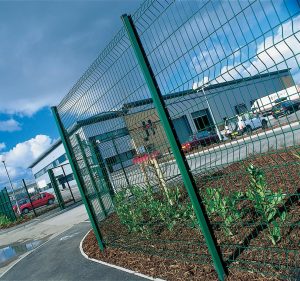
CCTV
CCTV (closed-circuit television) is a cost-effective deterrent and provides evidence to help secure convictions in the event of crimes being committed. Nevertheless, one of the main advantages of CCTV is that it provides an instant alert of an attempted break-in, thereby helping to prevent theft, vandalism and arson. For CCTV to be most effective when used in conjunction with fencing, the fencing should have a relatively open structure — such as weldmesh rather than palisade — to enable the camera to provide a view through the fence.
Access control
Some schools use gates with access control both to keep intruders out and prevent pupils from leaving during school hours. Even if access control is not an immediate requirement, it may be prudent to make allowance for its adoption in the future when specifying gates (see below).
Bollards and barriers
Depending on the layout of the school buildings and vehicular access, it may be necessary to install bollards and fixed barriers to prevent ram-raiding.
What type of fence posts to use?
Timber posts are unsuitable for security fencing, which leaves either concrete or steel — with a choice of RSA (rolled steel angle), RHS (rectangular hollow section) or CHS (circular hollow section). Factors to consider include strength, cost, aesthetics, requirement for toppings, and whether tamper-resistant barrel winders need to be concealed within a hollow section. Concrete is less prone to corrosion than galvanised, powder coated or painted steel, but it has a more industrial appearance.
Gates
Whenever there is a perimeter fence, there needs to be at least one access point. Gates are usually available from fencing suppliers to complement the specified type and design of fencing. It is important to ensure that the design and specification of the gates provides the same level of security as the fencing. While the size will depend on the type of access required (individuals, groups of people, or single or multiple vehicles), it is best practice to keep the access points as small in number and size as reasonably possible. For reasons of safety, it is recommended that separate gates are provided for vehicles and pedestrians, though positioning them adjacent to each other facilitates simpler monitoring.
Hinged and sliding gates are typically used at schools, though lifting barriers and road-mounted barriers are also appropriate in some circumstances.
Whatever type of gate or access is used, care must be taken to ensure that it is not vulnerable in comparison with the remainder of the perimeter security. For example, gates should be located where they are clearly visible, and all hinges and other mechanical components must be adequately maintained.
Note also that gates need to be considered in conjunction with the access controls if those are being specified or might be added in the future.
Security pitfalls to avoid
Whatever security measures are implemented, care should be taken to avoid the most commonly encountered pitfalls. These include holes that are left unrepaired, trees that grow up adjacent to fencing and make it easy to climb over, fences that are constructed alongside quiet, unlit roadways where a vehicle can readily — and without attracting attention — be parked alongside to provide an easy route over the fence, and other items such as wheeled rubbish bins that can be manoeuvred to aid climbing. Given the propensity for schools to be attacked by arsonists, it is important that rubbish and other flammable items are not stored in close proximity to the fencing.
The importance of correct installation
A fence is only as good as its installation. Poorly installed fencing detracts from the appearance of the premises, and everybody knows how important first impressions are; an invited visitor may see the poor fence as a reflection of the school’s own standards, while a potential intruder may look upon poorly installed fencing as a sign that the school pays little attention to security.
Furthermore, poorly installed fencing may be easier to breach in some cases, and it will be more likely to need repairs and maintenance earlier than would otherwise be necessary. In the worst case, an insurer may contest a claim if security fencing is deemed to be unsatisfactory.
Installing fencing is a skilled job and specifiers should be aware that some fencing contractors hire unskilled labour on a project-by-project basis, rather than retaining a team of properly trained installers.
Specifiers are strongly recommended only to use fencing contractors that are accredited to ISO 9001: 2000.
Secured by Design
Secured by Design (SBD) is an official police initiative that aims to reduce crime through effective environmental design. The scheme also calls for the installation of security products that meet police-approved standards.
Established by the Association of Chief Police Officers (ACPO) in 1989, SBD is now widely recognised within the building industry and is increasingly being listed in tenders as a mandatory requirement. Specifying SBD-accredited products (such as perimeter security fencing) and SBD-accredited installers help to demonstrate that appropriate steps are being taken to reduce crime. SBD is also recognised as a simple way to identify products that are effective in preventing crime, as the SBD logo is the only symbol guaranteeing national Police approval of products providing a realistic level of resistance to criminal attack. In order to be recognised by the SBD scheme, products have to be tested and approved by UKAS-accredited test houses as being compliant with specified standards.
Standards
Security fencing is covered by a number of British, European and international standards.
If in doubt, ask
Procter Fencing Systems is one of the UK’s leading specialist manufacturers of fencing and gates, with many years’ experience in school perimeter fencing. From its sites in Leeds, South Wales and Brentwood, Procter Fencing Systems offers a comprehensive service to survey, design, manufacture and install fencing and gates nationwide. All products are designed in accordance with the requirements of ISO 9001 and all meet the appropriate health, safety and product standards. Installation is carried out by the company’s own teams of skilled installers.
Procter Contracts also design, manufacture, supply and install products that are used in and around schools. These range from standard and customised powered gates (sliding, telescopic, swing and bi-folding types), through to walkways and shelters, cycle racks, bollards, barriers, benches, litter bins, secure bin stores and bespoke items. Schools or contractors wanting products from two or more of the three divisions benefit from a single senior point of contact, simplified communications and streamlined project management. Projects that are better co-ordinated are also more likely to be finished within the tight timescales to which schools work.

